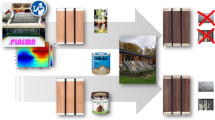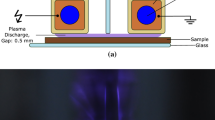Abstract
In this research, the effect of dielectric barrier discharge on mechanically manufactured (sawn, planed or polished) wood surfaces is investigated. The experiments have shown that the best hydrophilia is obtained with a cold plasma discharge in air under atmospheric pressure. Other gases such as helium, nitrogen, and argon have been tested, too. Changes of the wood surface properties were determined by absorption of water and contact angle measurements. As a result of a 1 to 20 seconds long exposure to plasma, wood surfaces became hydrophilic. The absorption of water in wood can be changed up to 22 times higher after plasma treatment in air for 20 seconds duration. The fracture strength of glued wood has been increased by 68% after this plasma pretreatment. Using plasma treatment in methane or acetylene wood surfaces are changed to hydrophobic properties. After plasma treatment for 1 min. in a Ar:CH4=80:20 gas mixture under atmospheric pressure, the absorption of water in wood is 32 times lower than without plasma treatment. As mentioned before, plasma treatment can produce hydrophobic and hydrophilic wood surfaces. But a good homogeneity of the gas discharge is necessary for the plasma treatment of wood.
Zusammenfassung
Im Rahmen dieser Arbeit werden die Auswirkungen der dielektrisch behinderten Entladung bei Atmosphärendruck auf mechanisch bearbeitete Holzoberflächen (gesägt, gehobelt oder geschliffen) untersucht. Die Experimente haben gezeigt, dass die höchste Hydrophilität bei einem in Luftatmosphäre gezündetem Plasma erreicht wird. Es werden auch andere Gase verwendet, wie z.B. Helium, Stickstoff und Argon. Zur Untersuchung der veränderten mechanischen und energetischen Eigenschaften der Holzoberflächen werden der Tropfen-Versuch und die Kontaktwinkelmessung verwendet. Durch eine 1 bis 20 Sekunden lange Plasmabehandlung können die Oberflächen hydrophil gestaltet werden. So kann die Eindringzeit von Wasser um Faktor 22 gesteigert werden durch eine 20 Sekunden lange Plasmabehandlung in Umgebungsluft. Die Bruchfestigkeit von Leimholz wird durch die gleiche Plasmavorbehandlung um 68% gesteigert. Werden als Plasmabehandlungsgas Methan oder Acetylen eingesetzt, so wird die Holzoberfläche hydrophob. Durch eine 60 Sekunden lange Plasmabehandlung in einem Ar:CH4=80:20 Gasgemisch bei Atmosphärendruck wird die Eindringszeit von Wasser um den Faktor 32 gesenkt. Mit Hilfe der Plasmabehandlung können also sowohl hydrophobe als auch hydrophile Holzoberflächen erzeugt werden. Jedoch wird für die Plasmabehandlung von Holz eine sehr homogene Gasentladung benötigt.









Similar content being viewed by others
References
Bikerman JJ (1967) A cohesive break of a weak boundary layer is the real event when failure seems to occur in the adhesion. Industrial and Engineering Chemistry 59(9):41–44
Donohoe K G, Wydeven T (1979) J Appl Polymer Sci 23:2591–2601
Gräfe F, Künzelmann U and Reinhard G (1989) Examination of the influence of vapour phase inhibitors on the wettability of the iron surface by contact angle measurements. Werkstoffe und Korrosion 40:437–440
Johansson I (1994) Hållfastheten hos limfogar med ändträytor; Del 2: Mikrostrukturen hos maskinbearbetade ändträytor av gran. Teknisk rapport, TRITA-TRÄ R-94–4.Sthlm: KTH (in Swedish)
Johansson I, Stehr M (1997) Weak boundary layers on machined pine and spruce surfaces. Paper at Forest Prod. Soc. Annual Meeting, Vancouver
Kanazawa S, Kogoma M, Okazaki S, Moriwaki T (1989) Nucl. Instrum. Methods in Phys. Res. B37/38:842–845
Kogelschatz U (2000) Fundamentals and applications of dielectric barrier discharges, Proc. HAKONE VII, 1:1–7
Kress L, Wessely B, Ripperger S (1999) Das Einbringen von Wassertropfen in unbehandeltes und holzschutzmittelbehandeltes Holz. Roh- Werkstoff 48:23–26
Linsley Hood J L (1980) Int. Conf. On Gas Discharges and their Applications, Edinburgh 86–90
Mahlberg R, Niemi HE-M, Denes F, Rowell RM (1998) Effect of oxygen and hexamethyldisiloxane plasma on morphology, wettability and adhesion properties of polypropylene and lignocellulosics. International Journal of Adhesion & Adhesives 18:283–297
Massines F, Gadri R B, Decomps P, Rabehi A, Ségur P, Mayoux C (1995) XXII. Int. Conf. On Phenomena in Ionized Gases, Hoboken 306–315
De Meier M, Militz H (2000) Wet adhesion of low-VOC coatings on wood. Progress in Organic Coatings 38:223–240
Meiners S, Salge JGH, Prinz E, Förster F (1998) Surf Coat Technol 98:1121–1127
Näser K-H, Lempe D, Regen O (1990) Physikalische Chemie für Techniker und Ingenieure Dt. Verl. für Grundstoffindustrie; 1990-Leipzig; ISBN 3-342-00545-9
Panzner M, Wiedemann G, Henneberg K, Fischer R, Wittke Th, Dietsch R (1998) Experimental investigation of the laser ablation process on wood surfaces. Applied Surface Science 127–129:787–792
Reitz U (1992) PhD Thesis, Technical University Braunschweig
Salge J (1996) Surf Coat Technol 80:1–7
Seltman J (1995) Freilegen der Holzstruktur durch UV-Strahlung. Holz als Roh- und Werkstoff 53:225–228
Schwarz R (1995) PhD Thesis, Technical University Braunschweig
Stafast H (1993) Angewandte Laserchemie Verfahren und Anwendungen. Chapter 8. Springer-Verlag, Berlin, Heidelberg, New York
Stehr M, Seltman J, Johanson I (1998) UV laser ablation—an improved method of sample preparation for microscopy. Holzforschung 52:1–6
Stehr M, Seltman J, Johansson I (1999) Laser ablation of machined wood surfaces. Holzforschung 53:93–103
Uehara T (1999) Adhesion Promotion Techniques, New York 139–174
Viöl W (1999) Verfahren zur Modifizierung von Holzoberflächen durch elektrische Entladung unter Atmosphärendruck. German patent DE 199 578 775
Wieneke S, Born S, Viöl W (2000) Sealed-off CO2 lasers excited by an all-solid-state 0.6 MHz generator. J Phys D Appl Phys 33:1282–1286
Acknowledgement
The financial support from the VW-Stiftung is gratefully acknowledged.
Author information
Authors and Affiliations
Corresponding author
Rights and permissions
About this article
Cite this article
Rehn, P., Viöl, W. Dielectric barrier discharge treatments at atmospheric pressure for wood surface modification. Holz Roh Werkst 61, 145–150 (2003). https://doi.org/10.1007/s00107-003-0369-6
Published:
Issue Date:
DOI: https://doi.org/10.1007/s00107-003-0369-6




